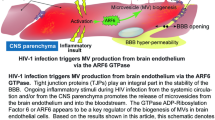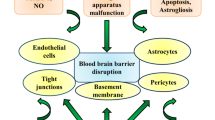Abstract.
The mechanism underlying the early invasion of the central nervous system by HIV-1 is unclear. Here, we summarize old and new findings supporting blood-brain barrier changes during HIV and experimental simian immunodeficiency virus (SIV) infection. The effect of inflammatory and toxic molecules secreted by monocytes and microglia on the functional integrity of tight junctions of brain endothelium is highlighted. Furthermore, recent findings on a possible direct role of the envelope and regulatory HIV-1 proteins (gp120, Tat, Nef) in causing the blood-brain barrier changes are reviewed. The possibility that these proteins, as circulating molecules, may bind to microvessel endothelial cells and cause blood-brain changes with no direct participation of the virus is raised. Several issues deserve further investigation and answers to these questions may provide keys for new therapeutic strategies in HIV-1 infection of the central nervous system.
Similar content being viewed by others
Author information
Authors and Affiliations
Corresponding author
Rights and permissions
About this article
Cite this article
Annunziata, P. Blood-brain barrier changes during invasion of the central nervous system by HIV-1. J Neurol 250, 901– 906 (2003). https://doi.org/10.1007/s00415-003-1159-0
Received:
Revised:
Accepted:
Issue Date:
DOI: https://doi.org/10.1007/s00415-003-1159-0




